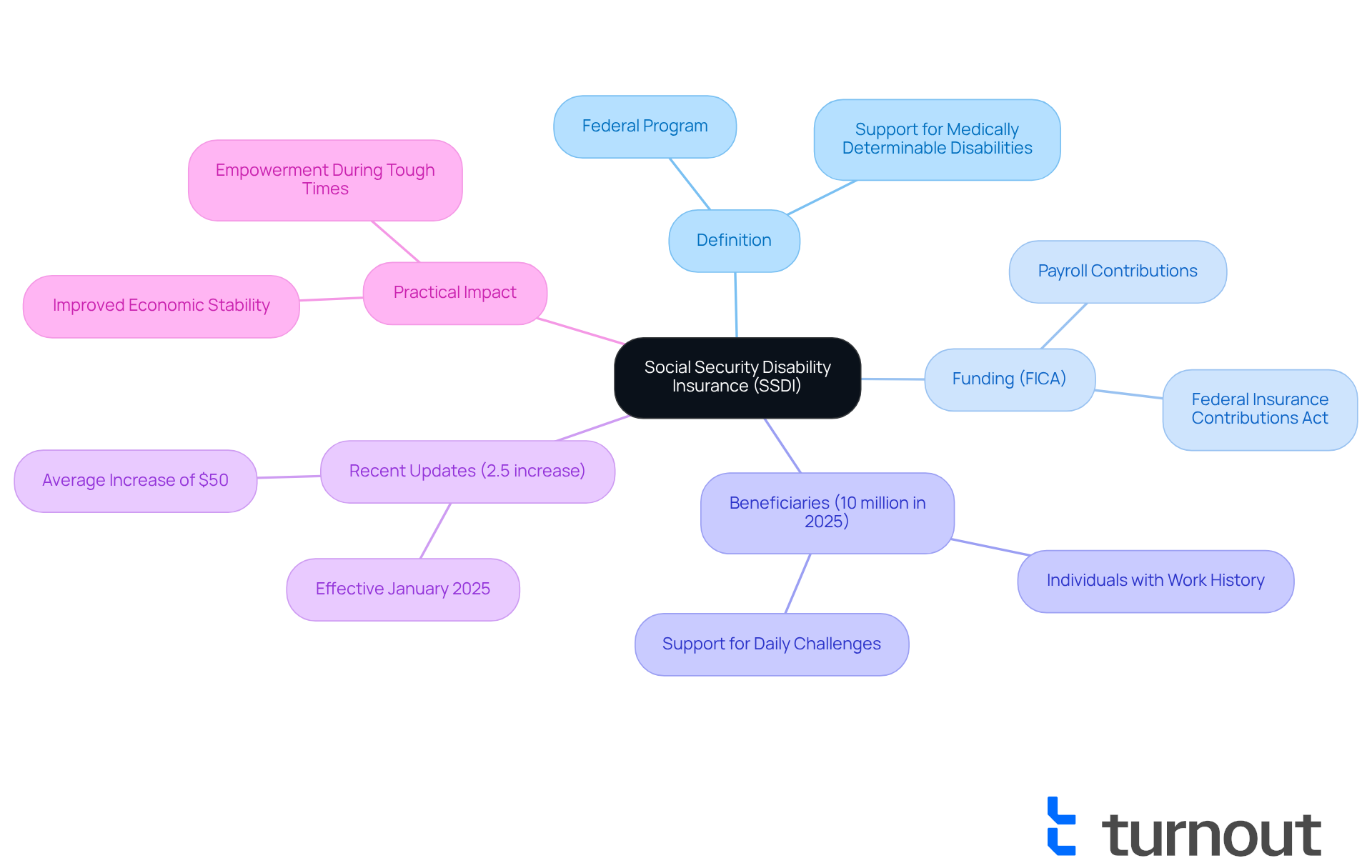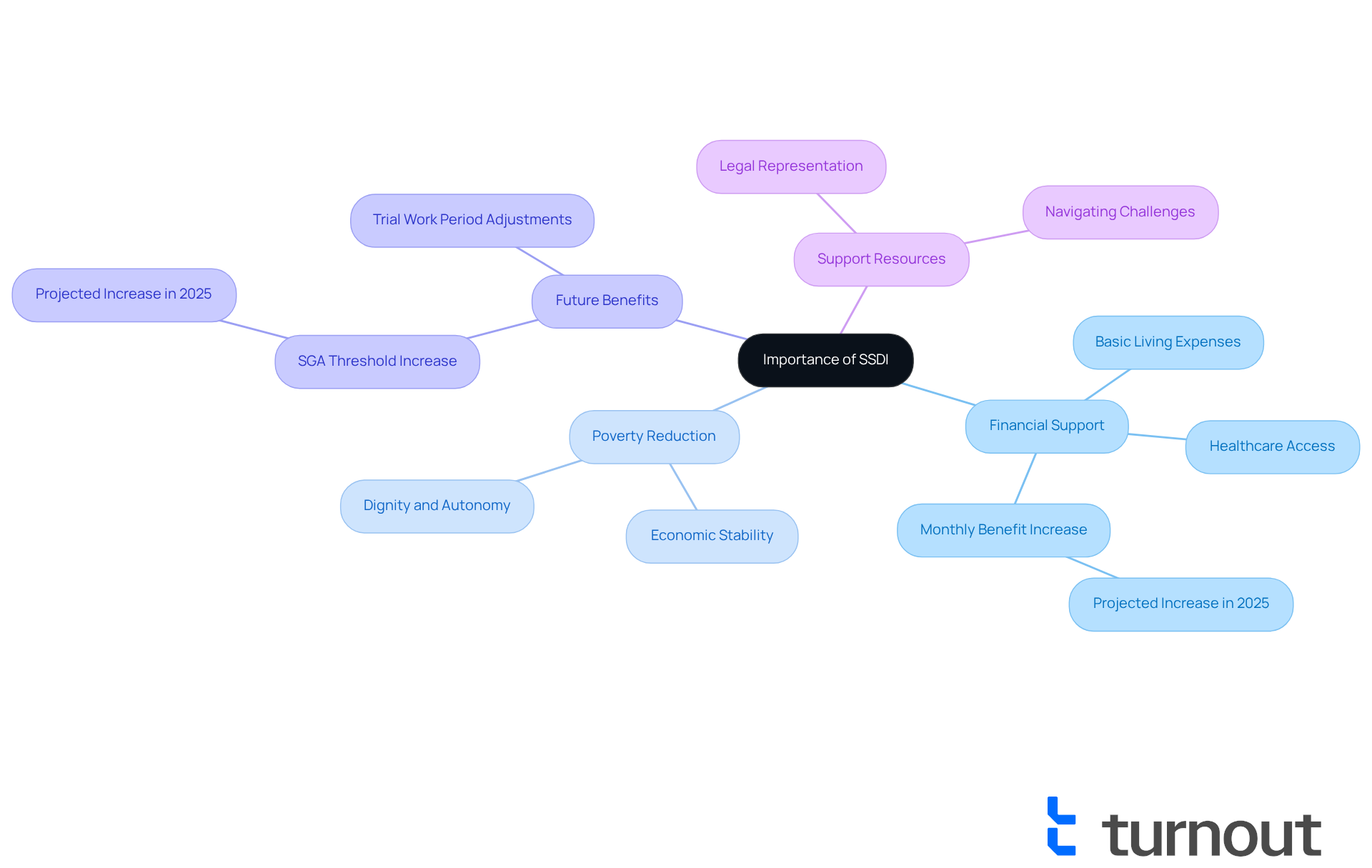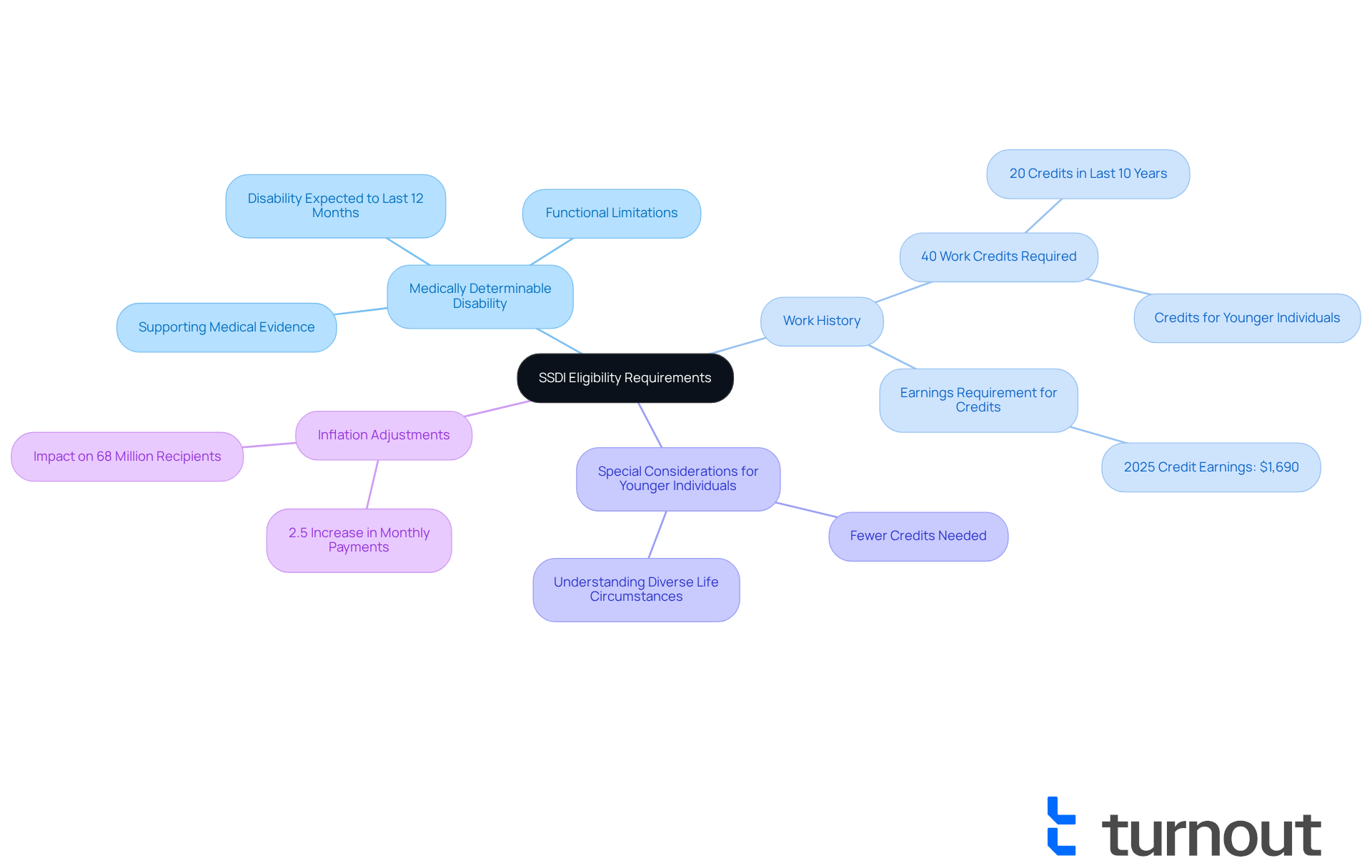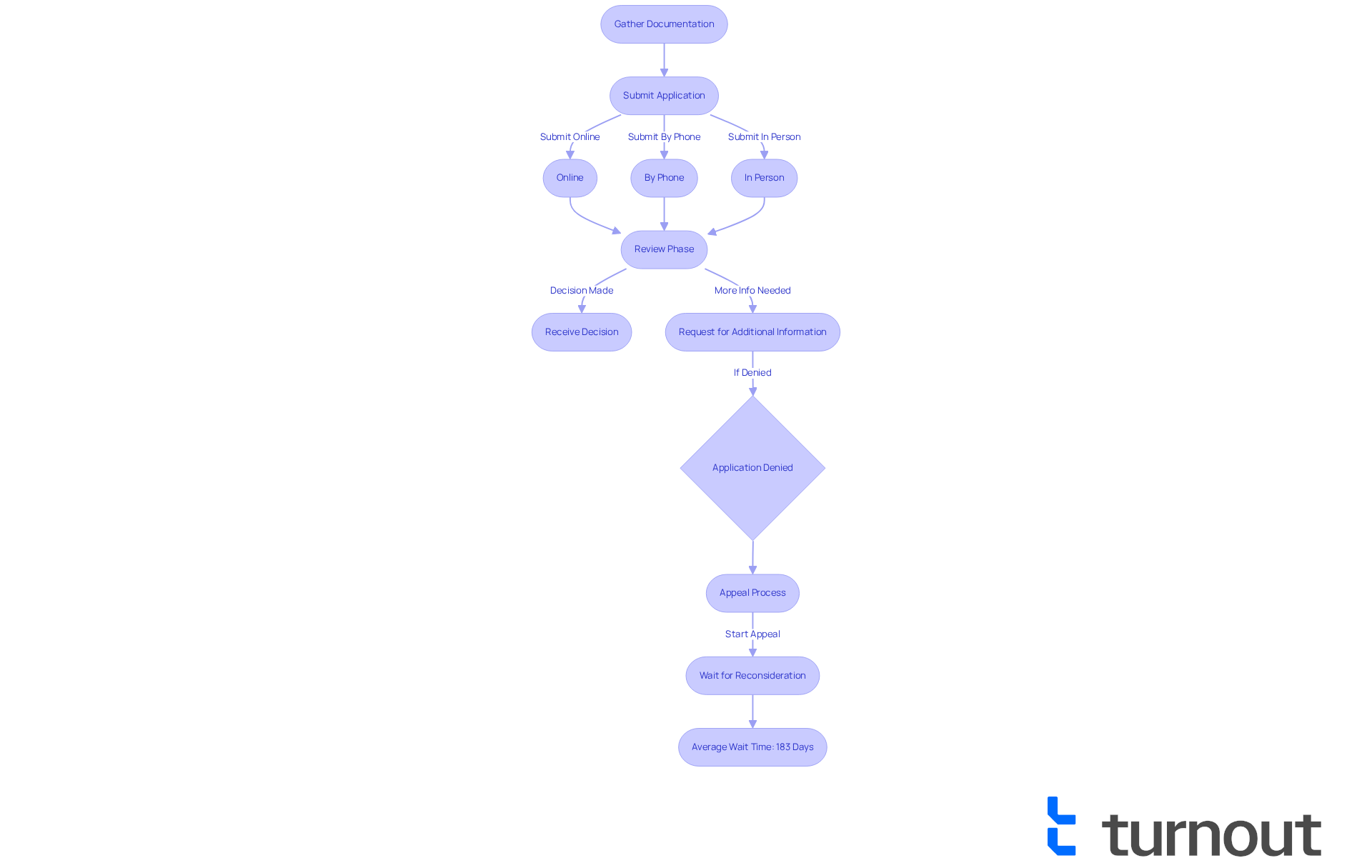Overview
Social Security Disability Insurance, or SSDI, is a vital federal program designed to provide financial support to those unable to work due to disabilities. We understand that navigating these challenges can be overwhelming. This program is funded through payroll contributions, ensuring that those in need receive the assistance they deserve.
SSDI plays a significant role in reducing poverty and enhancing the quality of life for disabled individuals. It offers essential income that can make a real difference in daily living. With anticipated increases in monthly benefits, recipients can find some peace of mind. Moreover, the flexibility to pursue part-time work can empower individuals to regain a sense of purpose.
We’re here to help you understand how SSDI can support you on your journey. You are not alone in this process, and there are resources available to assist you every step of the way. Consider exploring your options today—we believe you deserve the support you need.
Introduction
Understanding the intricacies of Social Security Disability Insurance (SSDI) is crucial for millions of Americans facing the challenges of disabilities. We recognize that this journey can be overwhelming. This federal program not only provides essential financial support but also plays a vital role in promoting autonomy and dignity for those unable to work.
As the number of beneficiaries continues to rise, it becomes increasingly important to grasp the eligibility requirements and application process. It's common to feel unsure about the key steps and criteria that potential applicants need to know to secure the benefits they deserve.
We're here to help you navigate this complex system with confidence.
Define SSDI: Understanding Social Security Disability Insurance
The ssdi meaning refers to Social Security Disability Insurance, which is a vital federal program designed to provide monthly financial support to individuals who are unable to work due to medically determinable disabilities. Financed through payroll contributions under the Federal Insurance Contributions Act (FICA), this program specifically serves those with a work history who have contributed to the Social Security system. This ensures they receive essential support when health conditions disrupt their ability to earn an income.
In 2025, approximately 10 million Americans are expected to receive disability support, highlighting the program's critical role in offering a safety net for those facing significant daily challenges due to impairments. Recent updates to the disability benefits program include a 2.5% increase in monthly assistance, providing an average of $50 more per recipient starting in January 2025. This adjustment is crucial, as it helps beneficiaries manage rising living costs and inflation.
Practical examples illustrate the program's impact: many disability beneficiaries have shared stories of improved economic stability, allowing them to focus on their health and well-being without the constant worry of financial uncertainty. Supporters emphasize the importance of disability benefits, explaining ssdi meaning as it not only delivers essential financial assistance but also empowers individuals to regain control over their lives during tough times. As the program continues to adapt, it remains a vital resource for those navigating the complexities of disability and financial hardship.

Explain the Importance of SSDI: Financial Support for Disabled Individuals
The ssdi meaning highlights the importance of Social Security Disability Insurance, which cannot be overstated. It serves as a vital income source for individuals unable to work due to disabilities, which is aligned with the ssdi meaning. For many, disability support payments are essential for covering basic living expenses like housing, food, and healthcare. In 2025, we anticipate that the typical monthly disability benefit amount will increase, providing even more support to those in need. Without this assistance, many individuals may find it difficult to maintain their quality of life and access necessary healthcare services.
The SSDI meaning highlights the significant role that Social Security Disability Insurance plays in reducing poverty rates among those with disabilities. It allows individuals to reach a level of financial stability that might otherwise seem unattainable, which illustrates the ssdi meaning. Economists widely recognize the program's impact on poverty alleviation. It not only provides financial support but also fosters a sense of dignity and autonomy for beneficiaries. Many individuals express that the ssdi meaning is crucial as it helps them understand how disability support payments allow them to afford necessary healthcare, which greatly enhances their overall well-being.
Looking ahead, the expected increase in Substantial Gainful Activity (SGA) thresholds in 2025 will allow SSDI recipients to earn additional income while still receiving support. This flexibility encourages individuals to pursue part-time work opportunities without the immediate fear of losing their benefits. Ultimately, this contributes to a better quality of life. The program's ability to assist disabled Americans in navigating financial challenges underscores its importance in promoting economic stability, which is closely related to the ssdi meaning.
We understand that navigating these challenges can be overwhelming, but know that you are not alone in this journey. We’re here to help you find the support you need.

Outline Eligibility Requirements for SSDI: Who Qualifies for Benefits
To qualify for Social Security Disability Insurance (SSDI), we understand that the SSDI meaning involves specific criteria established by the Social Security Administration (SSA) that applicants must meet. Firstly, individuals must demonstrate a medically determinable disability that prevents them from engaging in substantial gainful activity (SGA). This condition should be expected to last at least 12 months or lead to death. Additionally, a sufficient work history is typically required, generally needing 40 work credits, with at least 20 of those credits earned in the last 10 years prior to the onset of the disability. However, younger individuals may qualify with fewer work credits, reflecting the SSA's understanding of diverse life circumstances.
For instance, the Smith family from Waco, TX, shared their gratitude after successfully securing their disability support, emphasizing the positive impact of meeting these eligibility criteria. As of August 2025, the disability support program is undergoing updates, including a 2.5% increase in monthly payments due to inflation, which will aid approximately 68 million recipients. This adjustment underscores the importance of staying informed about eligibility requirements and changes in the disability benefits program.
Understanding the SSDI meaning and these requirements is vital for potential applicants, as it directly affects their ability to obtain the benefits they need. The SSA's guidelines indicate that even if a condition isn't specifically listed in their comprehensive Listing of Impairments, individuals may still be eligible for disability benefits based on their functional limitations and supporting medical evidence. As the framework of disability benefits evolves, it’s crucial to remain informed about eligibility criteria and application procedures. Remember, you are not alone in this journey; we're here to help you navigate the process.

Detail the Application Process for SSDI: Steps to Secure Your Benefits
Navigating the disability benefits application process can feel overwhelming. However, understanding the essential steps can significantly improve your chances of approval. The first step is gathering vital documentation, such as:
- Medical records
- Work history
- Personal identification
You can submit your application online through the SSA website, by phone, or in person at your local Social Security office. After submission, your application enters a review phase where the SSA evaluates the medical evidence and work history. This review can take several months, during which you may receive a decision or a request for additional information.
In 2025, the approval rate for initial disability benefits applications is approximately 38%. This statistic highlights the challenges many face in this journey. If your application is denied, you have the right to appeal, which involves additional steps to present your case. The average wait time for a reconsideration appeal is about 183 days, which can extend the overall timeline. Being well-prepared and knowledgeable is crucial for obtaining the disability assistance you deserve.
Turnout offers valuable support throughout this process. Their trained nonlawyer advocates can help you understand the documentation requirements and prepare your application effectively. It's important to note that Turnout is not a law firm, and their advocates do not provide legal representation. Recent updates show that the SSA is working to address backlogs, but applicants may still face extended wait times due to staffing shortages and increased demand. Advocates emphasize that understanding the documentation requirements and being proactive in communication can help mitigate some common challenges during the application process.
For instance, having complete and accurate medical records can significantly influence the outcome of your application. Many denials stem from inadequate information. Overall, thorough preparation and awareness of the SSDI meaning, along with support from Turnout, are essential for individuals who are seeking the benefits they truly deserve. Remember, you are not alone in this journey, and we’re here to help you every step of the way.

Conclusion
Understanding the meaning and significance of Social Security Disability Insurance (SSDI) is crucial for those navigating the challenges of disability and financial instability. We understand that SSDI serves as a lifeline for individuals unable to work due to medical conditions, providing essential financial support that enables them to maintain a basic quality of life. This program not only alleviates economic distress but also empowers beneficiaries to regain control over their circumstances, underscoring its vital role in society.
Throughout this article, we highlighted key points about the SSDI program, including:
- Its funding mechanisms
- Eligibility requirements
- The application process
It's important to note the expected increase in benefits and the flexibility to earn additional income while receiving support—significant developments that enhance the program's effectiveness. Real-life examples illustrate the positive impact SSDI has on individuals and families, reinforcing the importance of staying informed about changes and requirements.
In conclusion, SSDI is more than just a financial safety net; it represents hope and dignity for millions of Americans living with disabilities. As the program evolves to meet the needs of its beneficiaries, we encourage potential applicants to understand the application process and eligibility criteria. Seeking assistance and staying proactive can make a significant difference in securing the benefits needed to navigate life's challenges. Embracing the opportunities that SSDI offers can lead to a more stable and fulfilling life for those who qualify. Remember, you are not alone in this journey; we're here to help.
Frequently Asked Questions
What does SSDI stand for?
SSDI stands for Social Security Disability Insurance, a federal program that provides monthly financial support to individuals unable to work due to medically determinable disabilities.
Who is eligible for SSDI benefits?
Individuals who have a work history and have contributed to the Social Security system are eligible for SSDI benefits if they are unable to work due to disabilities.
How is the SSDI program funded?
The SSDI program is financed through payroll contributions under the Federal Insurance Contributions Act (FICA).
How many Americans are expected to receive SSDI support in 2025?
Approximately 10 million Americans are expected to receive disability support from the SSDI program in 2025.
What recent updates have been made to the SSDI benefits program?
Recent updates include a 2.5% increase in monthly assistance, providing an average of $50 more per recipient starting in January 2025.
Why are the updates to SSDI benefits important?
The updates are important as they help beneficiaries manage rising living costs and inflation, providing essential financial support during challenging times.
How do SSDI benefits impact beneficiaries' lives?
Many beneficiaries report improved economic stability, allowing them to focus on their health and well-being without the constant worry of financial uncertainty.
What is the significance of SSDI benefits according to supporters?
Supporters emphasize that SSDI benefits not only provide essential financial assistance but also empower individuals to regain control over their lives during difficult times.




